Save Water, Energy & Time
Economical, easy-to-install recirculation systems from AquaMotion, ACT and Laing cut the wait for hot water. Long waits for hot water are more than just irritating - they cost money and waste water and energy. A home with 5 taps can waste up to 15,000 gallons of tempered water down the drain every year. There's a simple and inexpensive way to solve this problem in your existing home or avoid it in your new home: an instant hot water system.
The Benefits of a Hot Water Recirculation System:
• Hot Water Comfort at Every Faucet
• Save Time, No More Waiting For Hot Water
• Save Hot Water, 12,000 – 15,000 Gallons a Year
• Save Energy with Timer, Save on Utility and Sewer Bills
• Save More with ON DEMAND Systems
• Go Green, Help Conserve this Precious Water Resource
• Meet local Plumbing Codes
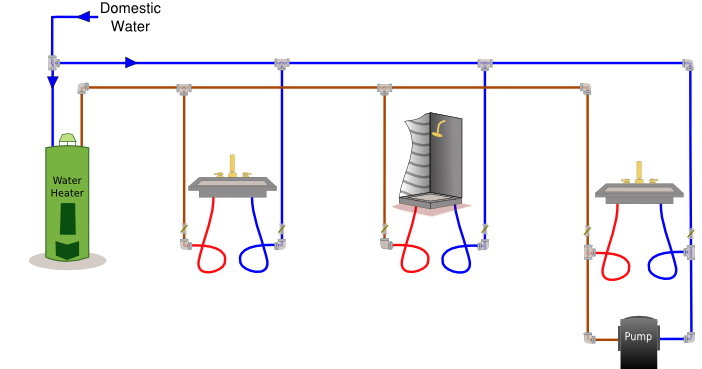



As you can see in the diagram, there is no need for a dedicated recirculation line!
- The convenience of nearly instant hot water throughout the house
- Substantial water and energy savings year over year
- Easy installation with most existing plumbing systems
- Silent, maintenance-free operation
The problem of course is that water heated by your water heater sits in the line between the heater and the tap(s) where it cools off. Let's call this "previously hot" water. When you turn on the tap you need to flush out this previously hot water to get to the fresh hot stuff. With low-flow faucets and long plumbing runs, this can take a long time - and waste a lot of water. And it can cause problems for your appliances too - forcing washers and dishwashers to use more time and energy heating their own water (or worse, run with water not hot enough to clean).
An instant hot water system - or hot water recirculation system - flushes the previously hot water back into the hot water tank (rather than you running it down the drain) so you have freshly heated water waiting for you when you turn on the faucet - instant hot water. Most instant hot water systems use the same basic approach - a special pump flushes previously hot water from the hot water line, sending it back to the heater through the cold water line.
Yes, you can use a recirculation pump with a tankless water heater. A tankless water needs a minimum flow before it will turn on. That's why you need a stronger pump. All 3 of our brands offer bigger/stronger pumps for tankless water heater applications.
If you have a dedicated recirculation line, you have more choices. You can use a pump that is designed for an non-dedicated return, or you can use a pump that runs almost continuously (this will use more heat energy).
A good compromise is to use a Laing or AquaMotion pump with a timer module. The timer would be set to run when you expect to use hot water - mornings and evenings perhaps.
Hot Water Recirculation Systems
Hot Water Recirculation Pumps - NON TANKLESS
Multiple styles of pumps for tank type water heaters.
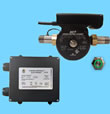
Hot Water Recirculation Pumps - FOR TANKLESS
Larger pumps for very long pluming runs and for tankless water heaters. Some pumps are timer operated and others via on-demand buttons.
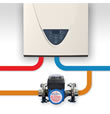
Outdoor Hot Water Recirculation Pumps
Outdoor rated pumps for hot water recirculation. Typically used on outdoor tankless water heaters. Dedicated and standard plumbing systems.
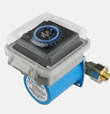
ECM Circulating Pumps
ECM motor circulating pumps for heating systems. Cast iron and stainless steel models.
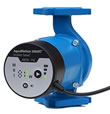
Cast Iron Circulator Pumps
Cast iron circulators designed for closed loop hydronic heating and cooling systems.
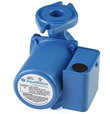
Stainless Circulator Pumps
Stainless steel circulators for open loop domestic, solar, hot water and potable water systems.
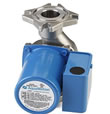
Solar Recirculation Pumps
Solar (DC voltage) powered pumps for hot water recirculation and general duties.
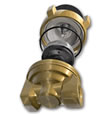
Differences between systems
Differences lie in how the systems are activated and how fast they work. The Laing AutoCirc1 performs a flush whenever it senses the water temperature has fallen below a certain level; the ACT D'MAND systems are, as the name implies, "on demand" - a high-speed flush is triggered by either button or motion sensor. With the Metlund and Laing AutoCirc1 systems, the pump installs at the most remote fixture (at the end of the plumbing run).
How much do instant hot water systems save?
Water savings for a household of four occupants varies from about 900 gallons to about 3000 gallons per point of use, per year (DOE study). Point of use is a single location at a home, for example a faucet where hot water is available. The water savings in a home with four points of use, on the average, would be 3,600 to 12,000 gallons per year. So, conservatively, if your home saved only 20 gallons of water each day (7,300 gallons per year) then in one year you could save between $100 and $200, considering water, energy and sewage charges.
Usage considerations
Once installed, these systems are quiet, dependable and maintenance-free. Laing provides a 2 year warranty on their units (from the manufacture date or 1 year from the purchase date, whichever is greater) while Metlund provides a 5-year warranty. The Metlund systems are activated by users and so household members need to adapt their habits a bit (basically you just learn to hit the button as you walk into the bathroom).
Physical placement
The pump units are located at the last fixture on your plumbing run (for example under a sink). If you are not sure of the layout of your plumbing, try following the pipes from the heater if that is possible - or call a professional plumber.
why buy from us?
We're engineers passionate about home ventilation and serious about customer service – so you can count on us for carefully-selected equipment and expert advice to ensure your project is a success from specification to installation.
Your call is answered by qualified people who will gladly discuss your project in detail, advise you professionally and never sell you inappropriate products.


